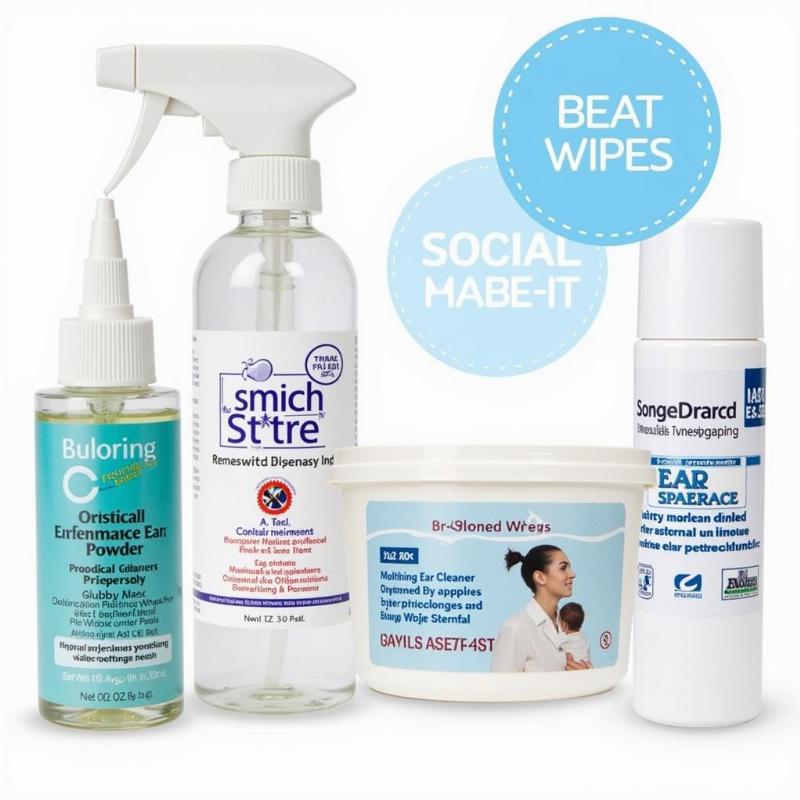Ear cleaning is a crucial aspect of pet care, particularly for dogs and cats. Regular ear cleaning helps prevent infections, removes wax buildup, and keeps your furry friend comfortable. Choosing the right ear cleaner for dogs and cats can be daunting, given the variety of products available on the US market. This guide will equip you with the knowledge to select the best ear cleaner and implement a safe and effective cleaning routine.
Understanding Your Pet’s Ears
Before diving into the specifics of ear cleaners, it’s essential to understand the basic anatomy of your pet’s ears. Both dogs and cats have L-shaped ear canals, which can trap debris and moisture, creating a breeding ground for bacteria and yeast. Certain breeds, like those with floppy ears or excessive hair growth within the ear canal, are even more susceptible to ear problems.
Choosing the Right Ear Cleaner for Dogs and Cats
The US market offers a wide array of ear cleaning solutions, each designed for different purposes. Some cleaners are formulated for routine maintenance, while others target specific ear issues like infections or mite infestations. Always consult with your veterinarian to determine the best ear cleaner for your individual pet’s needs. They can recommend a product that addresses any underlying conditions and is safe for your dog or cat.
Types of Ear Cleaners
- Ceruminolytic Ear Cleaners: These solutions help break down and dissolve earwax, making it easier to remove.
- Antiseptic Ear Cleaners: Designed to kill bacteria and yeast, these are often used for treating ear infections.
- Drying Ear Cleaners: Ideal for pets prone to swimmer’s ear or those with excessive moisture in their ears, these help dry the ear canal and prevent further issues.
 Types of Dog and Cat Ear Cleaners
Types of Dog and Cat Ear Cleaners
How to Clean Your Pet’s Ears
Proper ear cleaning technique is crucial for preventing injury and ensuring effectiveness. Follow these steps for a safe and comfortable experience:
- Gather your supplies: Ear cleaner recommended by your vet, cotton balls or gauze squares, and treats for positive reinforcement.
- Restrain your pet: Gently but firmly hold your pet to prevent sudden movements.
- Fill the ear canal: Carefully follow the instructions on the ear cleaner bottle for the correct amount to use.
- Massage the base of the ear: Gently massage the base of the ear for 30 seconds to distribute the cleaner and dislodge debris.
- Allow your pet to shake: Your pet will naturally shake their head, helping to further dislodge debris and excess cleaner.
- Wipe the outer ear: Use cotton balls or gauze to wipe away any visible debris and cleaner from the outer ear. Never insert anything into the ear canal itself.
Signs of Ear Problems in Dogs and Cats
Be vigilant for any signs of ear problems in your pet, including excessive scratching, head shaking, redness, swelling, discharge, or a foul odor. If you notice any of these symptoms, contact your veterinarian immediately. Early intervention is key to preventing more serious complications.
Conclusion
Regular ear cleaning with the right ear cleaner for dogs and cats is an essential part of responsible pet ownership in the US. By understanding your pet’s ear health needs and implementing a proper cleaning routine, you can help ensure their comfort and well-being. Remember to always consult with your veterinarian for personalized advice and recommendations.
FAQ
- How often should I clean my pet’s ears? The frequency of ear cleaning depends on your pet’s breed and individual needs. Consult with your vet for a personalized recommendation.
- Can I use human ear cleaners on my pets? No, human ear cleaners are not formulated for pets and can be harmful.
- What should I do if my pet’s ears are red and inflamed? Contact your veterinarian immediately as this could be a sign of infection.
- Is it normal for my pet to shake their head after ear cleaning? Yes, this is a natural reflex to help remove excess cleaner and debris.
- What are the signs of ear mites in dogs and cats? Common signs include excessive scratching, head shaking, dark brown or black discharge, and a foul odor.
- Can certain foods contribute to ear problems in pets? Yes, food allergies can sometimes manifest as ear infections.
- Are there any home remedies for cleaning my pet’s ears? It’s best to avoid home remedies and stick to veterinarian-approved ear cleaning solutions.
Related Articles
- are cats dirtier than dogs
- petarmor ear mite and tick treatment for dogs
- vaseline for ear mites in dogs
Beautdogs.us is your premier destination for comprehensive dog care information, breed-specific advice, and access to top-quality products and services. Whether you’re a new dog owner or a seasoned expert, Beautdogs.us provides reliable, expert-driven resources to ensure your canine companion thrives. Contact us today for personalized support! Email: [email protected], Phone: +1 501-555-7529. Visit Beautdogs.us for more information.